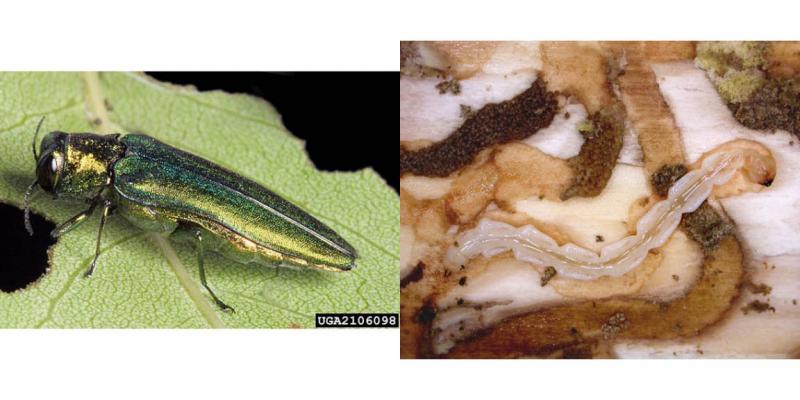EMERALD ASH BORER

What is the Emerald Ash Borer?
Emerald ash borer (EAB) is a beetle native to Asia introduced to Detroit, MI in 2002. It has destroyed tens of millions of true ash species in over 25 states, including Nebraska, forests, windbreaks, and urban trees. Almost 44 million Nebraska ash trees will be lost in the coming years. Many leading EAB researchers speculate that it has the potential to “functionally” wipe out the ash species with devasting economic and ecological impacts.
Why should I be concerned?
EAB is able to kill all ash trees, regardless of their health, age, or size. It has killed hundreds of millions of ash trees already in the U.S. As of October 2022, EAB was found in several locations in Nebraska: Omaha, Greenwood, Lincoln, Fremont, Ashland, and North Platte. EAB advancing westward across the state is not for debate; it is unknown how many years it will take.
What does EAB look like?
Adults are green beetles approximately half an inch long with slender bodies. Larvae are cream-colored and up to 1 ¼ inches long. Larvae have brown heads and a 10-segmented body with bell-shaped segments near the back end.
What are the symptoms of EAB, and which trees do they attack?
Symptoms include canopy thinning and branch dieback usually beginning in the top of the tree, sprouting from the base of the tree, bark splitting, zigzag tunnels under the bark, D-shaped exit holes 1/8 inch across, and bark stripping from woodpecker activity. EAB attacks and kills all species of North American ash, including white, green, and black ash. Common varieties of ash include Patmore, Marshall’s Seedless, and Autumn Purple ash. Mountain ash is not affected because they are not true ash.
How is EAB Spread?
EAB spreads mostly through human-assisted movements, such as moving infested firewood and nursery stock. Moving firewood and nursery stock out of infested areas is regulated by state and federal quarantines to prevent the spread. Visit www.dontmovefirewood.org for more information.
Should I treat my ash tree?
Treatments should only be considered generally if EAB has been detected within 15 miles of your location and if the trees are in good health and in a good location in the landscape. One treatment available for use is a soil application of imidacloprid (such as Bayer Advanced 12-Month Tree and Shrub Insect Control). The application should be applied in May and is most effective on small trees, generally less than 15 inches in trunk diameter. Tree care professionals are able to use additional products, such as trunk injections and trunk foliage sprays. Contact a certified arborist for these treatments.
Who can I call if I think my tree has EAB?
If your ash tree has EAB, contact the Nebraska Department of Agriculture at 402-471-2351 or your local forester with the Nebraska Forest Service. If you do not know your local forester, contact the Lewis and Clark Natural Resources District at 402-254-6758.
